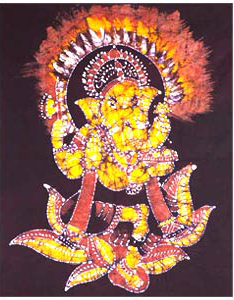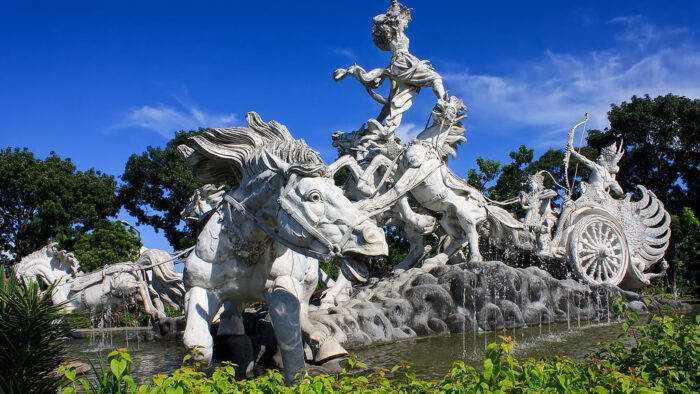Prime Minister Narendra Modi in his speech at the foundation of the Ram Mandir in early August mentioned Indonesia when he referred to the legacy that the Ramayana had left behind in the Asian countries. The Indonesian people still cherish the Indic values left behind by their ancestors.
Ma Archana of Indonesia or known as Maya Safira, is the Director of L’Ayurveda. She recently spoke about the role and presence of Sanathana Dharma in Indonesia. Sanatana Dharma gives colour to the life of the people of Indonesia through celebrations and customs right from how the people greet each other to the ways of worship and living.
She hails from West Java where the harvest festival is celebrated with great enthusiasm. “The people carry their offerings to Devi Sri, who is also known as Nyai Pohaci Sanghyang Asri. In Bharat she is known as Sridevi and in Indonesia as Devi Sri. We worship her not only for a bountiful harvest but also for wealth and welfare.”
Indonesia is an agrarian society, and produces a lot of grains. The Sekatan festival is celebrated in Central Java on the day of the birth of Prophet Mohammed, yet she says the people make offerings in a manner which is similar to the values of Sanathana Dharma. Usually a mound of vegetables is offered. Many Muslims are named Mahendra Datta, Dewi, Jayanthi etc.
The indigenous Sunda Wiwitan celebrate the Wiwitan ceremony which is an expression of gratitude “towards the earth and the universe for giving produce to us, human beings. In one of its processions, Mbah Kaum (the village eldest) will harvest the first rice crops using ani-ani (palm knives; a traditional agricultural tool to harvest rice crops).”
Ma Archana says there are many similarities between India and Indonesia. “One of them is Gatot kaca (who is a superhero in Indonesia). The philosophies of Indonesians are actually based on Ramayana and Mahabharata. However, the Gatot Kaca is the most popular character besides Arjuna and Krishna. We believe that Gatot Kaca comes from the archipelago that you call now Indonesia and when Bheem and the Pandavas were expelled and roamed around the forest they reached this country. Bheema married Hidamba and their son was Gatot Kaca. Indonesians are very proud to name their sons Gatot because Gatot means someone who is full of muscles and someone who is diligent.”
She adds that this name is not used in India, “this is perhaps because we believe Gatot is from this country.”
Another popular statue here is the one depicting the Samudra Manthan which is famous throughout South East Asia. “The statue is now in Suvarnabhumi airport in Thailand. When one travels to Cambodia and Vietnam, you will find many statues of the stories of Samudhra Manthan.”
Indonesia also has Mount Meru in Central Java which is believed to be the center of Jambu dvipa. “If you see the map of Indonesia, it is actually a ring of fire and has the greatest volcano activity in the whole world resulting in many earthquakes. The people prayed that there should be stability. Meru is there to stabilize the earth and therefore the leaders in Indonesia bear the title Pakubuwono or Pakubvalam. Pakub means who stabilizes the world.”
She quotes Prof Arysio Nunes Dos Santos, who says “... the archeological evidence confirms the origin of civilization and even of humanity itself is in the Indies. British geneticist Prof Stephen Oppenheimer says a genetic study of the Balinese population found that there were connections to Indians.
When pictures of present day Sundaland are compared to around 2500 to 1400 BC, one can see the shape of the Elephant Trunk. “To better understand the history of Sundaland, this large land mass was submerged by the rising sea levels between the 1500 and 3000 BC and the word Sunda comes from Prakrit languages which means elephant trunk. Over a period of time, due to the gradual submergence of most of its land mass, the people of Sundaland migrated to safer places, to higher land.”
She says that in an ancient form of Sundanese they regard nature as a manifestation of the divine. “We respect the mountains, the trees and we shall do no harm to them as this verse says:
“The mountains may not be destroyed
The rivers may not be polluted
The ancestral injunctions should not be forgotten;
Revere trees and revere the forests,
Pose no harm to any of them
Otherwise all living beings shall certainly suffer.”
Another point, the ancient wisdom of Dvipantara (or in another term, Nusantara) which is the Indonesian archipelago believes in the philosophy of Tatvamasi.
“It is believed by the Javanese, Sundanese, Balinese and also in other parts of archipelago. In Bali, it is well known by the term “tri hita karana”. Actually, this word was created in the 1960s, but the concept has been there a long time ago. There is the Parahyangan Pamongan; Palamahan which talks about the respect to living beings and the devas. This is the concept of Tri hita Karana which is about Loka Samgraha.”
She adds that Indonesia also has some indigenous yoga scriptures in Sanskrit and Prakrit. “These ancient scripts were discovered by Prof Raghuveer in India. People did not understand what was written despite many attempts. Prof Raghuveer studied the inscriptions which were in Sanskrit and some Prakrit languages. Thanks to him, Indonesia has been able to discover most of these treasures.”

This connection also extends to art. “The patterns in Batik are philosophical and symbolic of the values of Sanata Dharma.” There are varied theories about the place and period of origin of Batik. In India, the roots of Batik can be traced to the 1st century AD. Traditionally, the Khatri community of Gujarat were the only set of artisans for this art. Today It is believed that the finest Batik designs in India come from the artisans of Cholamandalam near Chennai, Tamil Nadu. Batik printing is also done in Gujarat, Rajasthan, Andhra Pradesh, Maharashtra, West Bengal and Madhya Pradesh.
The word Hindu is not seen in the ancient scriptures available in the archipelago. It is always referred to as Shiva tatva and Jiva tatva. She narrates an interesting aspect of Indonesian temples. The steps are very high suggesting that they were built keeping in mind taller people. “It seems they were not made for the present shorter Indonesian people.When the first Europeans came to Indonesia they discovered that the people were actually tall and big built and I would like to connect it to Gatot kaca because Gatot Kaca was known for his strong built body.”
She says the German historian mentions that Indonesians were so big and tall and well built and strong that they could carry four sacks of grains of rice on their own. “However with colonization and famine that has been going on the older generations have perished and we are left with small bodies.”
When the excavation began in 2010 to build a new university library in the Islamic University of Indonesia, the construction team found two 1,100-year-old temples with two altars, lingam, yoni, and the statue of Ganesha within the complex. “Given the presence of a murti of Ganesha, there is a probability that our ancestors thought the place where they built the temple could be a place of study and knowledge,” writes Hadza Min Fadhli Robby a Lecturer at the Department of International Relations, Islamic University of Indonesia, Yogyakarta.
The preservation of oral, textual and visual Indic tradition through literary works like Kakawin Ramayana, the legendary architectural heritage like the Prambanan Temple and the continuing usage of Sanskrit for the motto of governmental agencies are evidence of Indian softpower in Indonesia, he adds.
Today many Indonesians greet by shaking hands and kissing the back of the hand. “Traditionally, when we greet each other our custom is to fold hands in Namaskara in Bali, West Java. The new ways are not our tradition. Our tradition has been anjali mudra wishing namaskar.”





